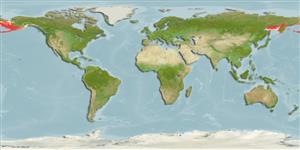Environment: milieu / climate zone / depth range / distribution range
Ökologie
seewasser demersal; tiefenbereich 0 - 325 m (Ref. 50610). Temperate; 65°N - 51°N, 140°E - 138°W (Ref. 57309)
North Pacific: Kotzebue Sound to the northern Sea of Japan, Sea of Okhotsk and Akun Island in the Aleutian chain (Ref. 6793); and adjacent Arctic, including Gulf of Alaska (Ref. 51659).
Size / Gewicht / Alter
Maturity: Lm ? range ? - ? cm
Max length : 21.6 cm SL Männchen/unbestimmt; (Ref. )
Rückenflossenstacheln (insgesamt): 8 - 11; Rückenflossenweichstrahlen (insgesamt): 6-9; Afterflossenstacheln 0; Afterflossenweichstrahlen: 13 - 16. Suprapectoral plates absent. Pectoral fin with 5 rows of blackish-brown spots. Resembles O. iburia in having blackish-brown spots on the pectoral fin, but differs by having no sub pectoral plate, 42 or fewer lateral line plates, and 30 to 37 supralateral plates.
Life cycle and mating behavior
Geschlechtsreife | Fortpflanzung | Ablaichen | Eier | Fecundity | Larven
Robins, C.R., R.M. Bailey, C.E. Bond, J.R. Brooker, E.A. Lachner, R.N. Lea and W.B. Scott, 1991. Common and scientific names of fishes from the United States and Canada. Am. Fish. Soc. Spec. Publ. (20):183 p. (Ref. 3814)
IUCN Rote Liste Status (Ref. 130435)
Bedrohung für Menschen
Harmless
Nutzung durch Menschen
Mehr Information
NamenSynonymeMetabolismusRäuberÖkotoxikologieFortpflanzungGeschlechtsreifeAblaichenSpawning aggregationFecundityEierEientwicklung
ReferenzenAquakulturAquakultur ProfilZuchtlinienGenetikElectrophoresesVererbbarkeitKrankheitenVerarbeitungNutrientsMass conversion
PartnerBilderStamps, Coins Misc.LauteCiguateraGeschwindigkeitSchwimmstilKiemenoberflächeOtolithsGehirngrößeSehfähigkeit
Tools
Zusatzinformationen
Download XML
Internet Quellen
Estimates based on models
Preferred temperature (Ref.
123201): -1.1 - 5.4, mean 1.9 °C (based on 531 cells).
Phylogenetic diversity index (Ref.
82804): PD
50 = 0.5625 [Uniqueness, from 0.5 = low to 2.0 = high].
Bayesian length-weight: a=0.00389 (0.00180 - 0.00842), b=3.12 (2.94 - 3.30), in cm total length, based on all LWR estimates for this body shape (Ref.
93245).
Trophic level (Ref.
69278): 3.2 ±0.4 se; based on diet studies.
Widerstandsfähigkeit (Ref.
120179): mittel, Verdopplung der Population dauert 1,4 - 4,4 Jahre. (Preliminary K or Fecundity.).
Fishing Vulnerability (Ref.
59153): Low vulnerability (16 of 100).
